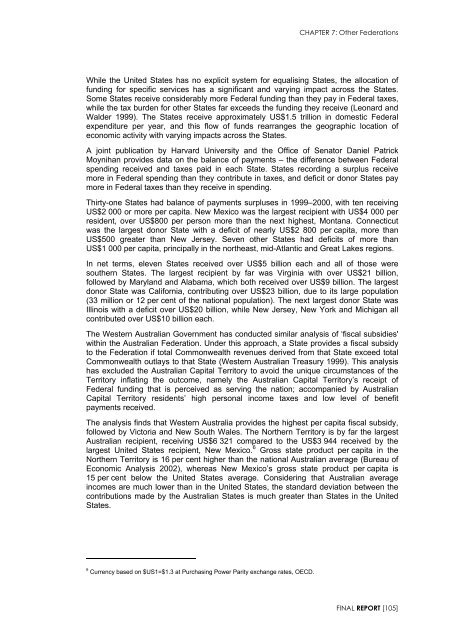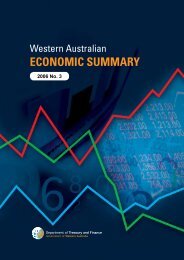Garnaut Fitzgerald Review of Commonwealth-State Funding
Garnaut Fitzgerald Review of Commonwealth-State Funding
Garnaut Fitzgerald Review of Commonwealth-State Funding
Create successful ePaper yourself
Turn your PDF publications into a flip-book with our unique Google optimized e-Paper software.
CHAPTER 7: Other Federations<br />
While the United <strong>State</strong>s has no explicit system for equalising <strong>State</strong>s, the allocation <strong>of</strong><br />
funding for specific services has a significant and varying impact across the <strong>State</strong>s.<br />
Some <strong>State</strong>s receive considerably more Federal funding than they pay in Federal taxes,<br />
while the tax burden for other <strong>State</strong>s far exceeds the funding they receive (Leonard and<br />
Walder 1999). The <strong>State</strong>s receive approximately US$1.5 trillion in domestic Federal<br />
expenditure per year, and this flow <strong>of</strong> funds rearranges the geographic location <strong>of</strong><br />
economic activity with varying impacts across the <strong>State</strong>s.<br />
A joint publication by Harvard University and the Office <strong>of</strong> Senator Daniel Patrick<br />
Moynihan provides data on the balance <strong>of</strong> payments – the difference between Federal<br />
spending received and taxes paid in each <strong>State</strong>. <strong>State</strong>s recording a surplus receive<br />
more in Federal spending than they contribute in taxes, and deficit or donor <strong>State</strong>s pay<br />
more in Federal taxes than they receive in spending.<br />
Thirty-one <strong>State</strong>s had balance <strong>of</strong> payments surpluses in 1999–2000, with ten receiving<br />
US$2 000 or more per capita. New Mexico was the largest recipient with US$4 000 per<br />
resident, over US$800 per person more than the next highest, Montana. Connecticut<br />
was the largest donor <strong>State</strong> with a deficit <strong>of</strong> nearly US$2 800 per capita, more than<br />
US$500 greater than New Jersey. Seven other <strong>State</strong>s had deficits <strong>of</strong> more than<br />
US$1 000 per capita, principally in the northeast, mid-Atlantic and Great Lakes regions.<br />
In net terms, eleven <strong>State</strong>s received over US$5 billion each and all <strong>of</strong> those were<br />
southern <strong>State</strong>s. The largest recipient by far was Virginia with over US$21 billion,<br />
followed by Maryland and Alabama, which both received over US$9 billion. The largest<br />
donor <strong>State</strong> was California, contributing over US$23 billion, due to its large population<br />
(33 million or 12 per cent <strong>of</strong> the national population). The next largest donor <strong>State</strong> was<br />
Illinois with a deficit over US$20 billion, while New Jersey, New York and Michigan all<br />
contributed over US$10 billion each.<br />
The Western Australian Government has conducted similar analysis <strong>of</strong> ‘fiscal subsidies'<br />
within the Australian Federation. Under this approach, a <strong>State</strong> provides a fiscal subsidy<br />
to the Federation if total <strong>Commonwealth</strong> revenues derived from that <strong>State</strong> exceed total<br />
<strong>Commonwealth</strong> outlays to that <strong>State</strong> (Western Australian Treasury 1999). This analysis<br />
has excluded the Australian Capital Territory to avoid the unique circumstances <strong>of</strong> the<br />
Territory inflating the outcome, namely the Australian Capital Territory’s receipt <strong>of</strong><br />
Federal funding that is perceived as serving the nation; accompanied by Australian<br />
Capital Territory residents’ high personal income taxes and low level <strong>of</strong> benefit<br />
payments received.<br />
The analysis finds that Western Australia provides the highest per capita fiscal subsidy,<br />
followed by Victoria and New South Wales. The Northern Territory is by far the largest<br />
Australian recipient, receiving US$6 321 compared to the US$3 944 received by the<br />
largest United <strong>State</strong>s recipient, New Mexico. 6 Gross state product per capita in the<br />
Northern Territory is 16 per cent higher than the national Australian average (Bureau <strong>of</strong><br />
Economic Analysis 2002), whereas New Mexico’s gross state product per capita is<br />
15 per cent below the United <strong>State</strong>s average. Considering that Australian average<br />
incomes are much lower than in the United <strong>State</strong>s, the standard deviation between the<br />
contributions made by the Australian <strong>State</strong>s is much greater than <strong>State</strong>s in the United<br />
<strong>State</strong>s.<br />
6<br />
Currency based on $US1=$1.3 at Purchasing Power Parity exchange rates, OECD.<br />
FINAL REPORT [105]

















